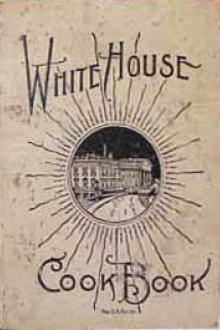The Whitehouse Cookbook (1887), Hugo Ziemann [world of reading .TXT] 📗

- Author: Hugo Ziemann
- Performer: -
Book online «The Whitehouse Cookbook (1887), Hugo Ziemann [world of reading .TXT] 📗». Author Hugo Ziemann
STEWED GREEN PEAS.
Into a saucepan of boiling water put two or three pints of young green peas and when nearly done and tender drain in a colander dry; then melt two ounces of butter in two of flour; stir well and boil five minutes longer; should the pods be quite clean and fresh boil them first in the water, remove and put in the peas. The Germans prepare a very palatable dish of sweet young pods alone by simply stirring in a little butter with some savory herbs.
SQUASHES, OR CYMBLINGS.
The green or summer squash is best when the outside is beginning to turn yellow, as it is then less watery and insipid than when younger. Wash them, cut them into pieces and take out the seeds. Boil them about three-quarters of an hour, or till quite tender. When done, drain and squeeze them well till you have pressed out all the water; mash them with a little butter, pepper and salt. Then put the squash thus prepared into a stewpan, set it on hot coals and stir it very frequently till it becomes dry. Take care not to let it burn.
Summer squash is very nice steamed, then prepared the same as boiled.
BOILED WINTER SQUASH.
This is much finer than the summer squash. It is fit to eat in August, and, in a dry warm place, can be kept well all winter. The color is a very bright yellow. Pare it, take out the seeds, cut it in pieces, and stew it slowly till quite soft in a very little water. Afterwards drain, squeeze and press it well; then mash it with a very little butter, pepper and salt. They will boil in from twenty to forty minutes.
BAKED WINTER SQUASH.
Cut open the squash, take out the seeds and without paring cut it up into large pieces; put the pieces on tins or in a dripping-pan, place in a moderately hot oven and bake about an hour. When done, peel and mash like mashed potatoes, or serve the pieces hot on a dish, to be eaten warm with butter like sweet potatoes. It retains its sweetness much better baked this way than when boiled.
VEGETABLE HASH.
Chop rather coarsely the remains of vegetables left from a boiled dinner, such as cabbage, parsnips, potatoes, etc.; sprinkle over them a little pepper, place in a saucepan or frying pan over the fire; put in a piece of butter the size of a hickory nut; when it begins to melt, tip the dish so as to oil the bottom and around the sides; then put in the chopped vegetables, pour in a spoonful or two of hot water from the tea-kettle, cover quickly so as to keep in the steam. When heated thoroughly take off the cover and stir occasionally until well cooked. Serve hot. Persons fond of vegetables will relish this dish very much.
SPINACH.
It should be cooked so as to retain its bright green color and not sent to table, as it so often is, of a dull brown or olive color; to retain its fresh appearance, do not cover the vessel while it is cooking.
Spinach requires dose examination and picking, as insects are frequently found among it and it is often gritty. Wash it through three or four waters. Then drain it and put it in boiling water. Fifteen to twenty minutes is generally sufficient time to boil spinach. Be careful to remove the scum. When it is quite tender, take it up, and drain and squeeze it well. Chop it fine, and put it into a saucepan with a piece of butter and a little pepper and salt. Set it on the fire and let it stew five minutes, stirring it all the time, until quite dry. Turn it into a vegetable dish, shape it into a mound, slice some hard-boiled eggs and lay around the top.
GREENS.
About a peck of greens are enough for a mess for a family of six, such as dandelions, cowslips, burdock, chicory and other greens. All greens should be carefully examined, the tough ones thrown out, then be thoroughly washed through several waters until they are entirely free from sand. The addition of a handful of salt to each pan of water used in washing the greens will free them from insects and worms, especially if after the last watering they are allowed to stand in salted water for a half hour or longer. When ready to boil the greens, put them into a large pot half full of boiling water, with a handful of salt, and boil them steadily until the stalks are tender; this will be in from five to twenty minutes, according to the maturity of the greens; but remember that long-continued boiling wastes the tender substances of the leaves, and so diminishes both the bulk and the nourishment of the dish; for this reason it is best to cut away any tough stalks before beginning to cook the greens. As soon as they are tender drain them in a colander, chop them a little and return them to the fire long enough to season them with salt, pepper and butter; vinegar may be added if it is liked; the greens should be served as soon as they are hot.
All kinds of greens can be cooked in this manner.
STEWED CARROTS.
Wash and scrape the carrots and divide them into strips; put them into a stewpan with water enough to cover them; add a spoonful of salt and let them boil slowly until tender; then drain and replace them in the pan, with two tablespoons of butter rolled in flour, shake over a little pepper and salt, then add enough cream or milk to moisten the whole; let it come to a boil and serve hot.
CARROTS MASHED.
Scrape and wash them; cook them tender in boiling water salted slightly. Drain well and mash them. Work in a good piece of butter and season with pepper and salt. Heap up on a vegetable dish and serve hot.
Carrots are also good simply boiled in salted water and dished up hot with melted butter over them.
TURNIPS.
Turnips are boiled plain with or without meat, also mashed like potatoes and stewed like parsnips. They should always be served hot. They require from forty minutes to an hour to cook.
STEWED PUMPKINS.
See stewed pumpkin for pie. Cook the same, then after stewing season the same as mashed potatoes. Pumpkin is good baked in the same manner as baked winter squash.
STEWED ENDIVE.
Ingredients.—Six heads of endive, salt and water, one pint of broth, thickening of butter and flour, one tablespoonful of lemon juice, a small lump of sugar.
Mode.—Wash and free the endive thoroughly from insects, remove the green part of the leaves, and put it into boiling water, slightly salted. Let it remain for ten minutes; then take it out, drain it till there is no water remaining and chop it very fine. Put it into a stewpan with the broth, add a little salt and a lump of sugar, and boil until the endive is perfectly tender. When done, which may be ascertained by squeezing a piece between the thumb and finger, add a thickening of butter and flour and the lemon juice; let the sauce boil up and serve.
Time.—Ten minutes to boil, five minutes to simmer in the broth.
BAKED MUSHROOMS.
Prepare them the same as for stewing. Place them in a baking-pan in a moderate oven. Season with salt, pepper, lemon juice and chopped parsley. Cook in the oven fifteen minutes, baste with butter. Arrange on a dish and pour the gravy over them. Serve with sauce made by heating a cup of cream, two ounces of butter, a tablespoonful of chopped parsley, a little cayenne pepper, salt, a tablespoonful of white sauce and two tablespoonfuls of lemon juice. Put in a saucepan and set on the fire. Stir until thick, but do not let boil. Mushrooms are very nice placed on slices of well-buttered toast when set into the oven to bake. They cook in about fifteen minutes.
STEWED MUSHROOMS.
Time, twenty-one minutes. Button mushrooms, salt to taste, a little butter rolled in flour, two tablespoonfuls of cream or the yolk of one egg. Choose buttons of uniform size. Wipe them clean and white with a wet flannel; put them in a stewpan with a little water and let them stew very gently for a quarter of an hour. Add salt to taste, work in a little flour and butter, to make the liquor about as thick as cream, and let it boil for five minutes. When you are ready to dish it up, stir in two tablespoonfuls of cream or the yolk of an egg; stir it over the fire for a minute, but do not let it boil, and serve. Stewed button mushrooms are very nice, either in fish stews or ragouts, or served apart to eat with fish. Another way of doing them is to stew them in milk and water (after they are rubbed white), add to them a little veal gravy, mace and salt and thicken the gravy with cream or the yolks of eggs.
Mushrooms can be cooked in the same manner as the recipes for oysters, either stewed, fried, broiled, or as a soup. They are also used to flavor sauces, catsups, meat gravies, game and soups.
CANNED MUSHROOMS.
Canned mushrooms may be served with good effect with game and even with beefsteak if prepared in this way: Open the can and pour off every drop of the liquid found there; let the mushrooms drain, then put them in a saucepan with a little cream and butter, pepper and salt; let them simmer gently for from five to ten minutes, and when the meat is on the platter pour the mushrooms over it. If served with steak, that should be very tender and be broiled, never in any case fried.
MUSHROOMS FOR WINTER USE.
Wash and wipe free from grit the small fresh button mushrooms. Put into a frying pan a quarter of a pound of the very best butter. Add to it two whole cloves, a saltspoonful of salt and a tablespoonful of lemon juice. When hot add a quart of the small mushrooms, toss them about in the butter for a moment only, then put them in jars; fill the top of each jar with an inch or two of the butter and let it cool. Keep the jars in a cool place, and when the butter is quite firm add a top layer of salt. Cover to keep out dust.
The best mushrooms grow on uplands or in high open fields, where the air is pure.
TRUFFLES.
The truffle belongs to the family of the mushrooms; they are used principally in this country as a condiment for boned turkey and chicken, scrambled eggs, fillets of beef, game and fish. When mixed in due proportion, they add a peculiar zest and flavor to sauces that cannot be found in any other plant in the vegetable kingdom.
ITALIAN STYLE OF DRESSING TRUFFLES.
Ten truffles, a quarter of a pint of salad oil, pepper and salt to taste, one tablespoonful of minced parsley, a very little finely minced garlic, two blades of pounded mace, one tablespoonful of lemon juice.
After cleansing and brushing the truffles, cut them into thin slices and put them in a baking-dish, on a seasoning of oil or butter, pepper, salt, parsley, garlic and mace in the above proportion. Bake them for nearly an hour, and just before serving add the lemon juice and send





Comments (0)